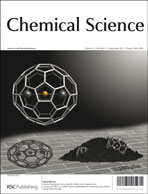Treatment of Ni(COD)2 with Me2C(CH2N![[double bond, length as m-dash]](https://www.rsc.org/images/entities/char_e001.gif) CHpy)2 (dmp(PI)2) afforded pseudo-square planar, diamagnetic {dmp(PI)22−}NiII (Ni[0]), which contains radical anion pyridine-imine (PI) units bound to Ni(II). Ag+ oxidation of Ni[0] provided [{dmp(PI)2}Ni]+ (Ni[+]) whose assignment as Ni(I) or Ni(II) was made on the basis of ab initio calculations, and EPR spectroscopy. Upon crystallization, Ni[+] formed an asymmetric dimer, [{dmp(PI)2}2NiIINi0]2+ (Ni[2+]Ni[0]), consisting of pseudo-octahedral Ni(II) and pseudo-tetrahedral Ni(0). Ferrocenium oxidation (2 equiv.) of Ni[0] provided [{dmp(PI)2}(MeCN)2NiII]2+ (Ni[2+]), while KC8 reduction provided [{dmp(PI)23−}NiII]−(K(THF)2)+ (Ni[−]) in polymeric form (K+ counterion) or as ion-pairs (with K+(crypt-2.2.2)). Excess K0 or 2 equiv. Cs0 and Ni[0] provided highly sensitive [{dmp(PI)24−}NiII]2− (Ni[2−]), which disproportionates with C
CHpy)2 (dmp(PI)2) afforded pseudo-square planar, diamagnetic {dmp(PI)22−}NiII (Ni[0]), which contains radical anion pyridine-imine (PI) units bound to Ni(II). Ag+ oxidation of Ni[0] provided [{dmp(PI)2}Ni]+ (Ni[+]) whose assignment as Ni(I) or Ni(II) was made on the basis of ab initio calculations, and EPR spectroscopy. Upon crystallization, Ni[+] formed an asymmetric dimer, [{dmp(PI)2}2NiIINi0]2+ (Ni[2+]Ni[0]), consisting of pseudo-octahedral Ni(II) and pseudo-tetrahedral Ni(0). Ferrocenium oxidation (2 equiv.) of Ni[0] provided [{dmp(PI)2}(MeCN)2NiII]2+ (Ni[2+]), while KC8 reduction provided [{dmp(PI)23−}NiII]−(K(THF)2)+ (Ni[−]) in polymeric form (K+ counterion) or as ion-pairs (with K+(crypt-2.2.2)). Excess K0 or 2 equiv. Cs0 and Ni[0] provided highly sensitive [{dmp(PI)24−}NiII]2− (Ni[2−]), which disproportionates with C![[double bond, length as m-dash]](https://www.rsc.org/images/entities/char_e001.gif) C bond formation and dehydrogenation to afford [{2-py,3-PI,4-Me2-azacyclopent-2-ene2−}2Ni]2− [K+(crypt-2.2.2)]2 (Ni[AcPP]) upon addition of crypt-2.2.2. All redox events may be construed as shuttling electrons in and out of the ligand scaffold. While radical character is implicated in the calculations of Ni[+], Ni[0], and Ni[−], the pseudo-square planar species are remarkably resilient to further reactivity, thereby highlighting the stability provided by this geometry.
C bond formation and dehydrogenation to afford [{2-py,3-PI,4-Me2-azacyclopent-2-ene2−}2Ni]2− [K+(crypt-2.2.2)]2 (Ni[AcPP]) upon addition of crypt-2.2.2. All redox events may be construed as shuttling electrons in and out of the ligand scaffold. While radical character is implicated in the calculations of Ni[+], Ni[0], and Ni[−], the pseudo-square planar species are remarkably resilient to further reactivity, thereby highlighting the stability provided by this geometry.
![Graphical abstract: Exploring the limits of redox non-innocence: pseudo square planar [{κ4-Me2C(CH2N [[double bond, length as m-dash]] CHpy)2}Ni]n (n = 2+, 1+, 0, −1, −2) favor Ni(ii)](/en/Image/Get?imageInfo.ImageType=GA&imageInfo.ImageIdentifier.ManuscriptID=C3SC50743B&imageInfo.ImageIdentifier.Year=2013)
You have access to this article
 Please wait while we load your content...
Something went wrong. Try again?
Please wait while we load your content...
Something went wrong. Try again?
![[double bond, length as m-dash]](https://www.rsc.org/images/entities/char_e001.gif) CHpy)2}Ni]n (n = 2+, 1+, 0, −1, −2) favor Ni(ii)†
CHpy)2}Ni]n (n = 2+, 1+, 0, −1, −2) favor Ni(ii)† ![[double bond, length as m-dash]](https://www.rsc.org/images/entities/char_e001.gif) CHpy)2 (dmp(PI)2) afforded pseudo-square planar, diamagnetic {dmp(PI)22−}NiII (Ni[0]), which contains
CHpy)2 (dmp(PI)2) afforded pseudo-square planar, diamagnetic {dmp(PI)22−}NiII (Ni[0]), which contains ![[double bond, length as m-dash]](https://www.rsc.org/images/entities/char_e001.gif) C bond formation and
C bond formation and ![Graphical abstract: Exploring the limits of redox non-innocence: pseudo square planar [{κ4-Me2C(CH2N [[double bond, length as m-dash]] CHpy)2}Ni]n (n = 2+, 1+, 0, −1, −2) favor Ni(ii)](/en/Image/Get?imageInfo.ImageType=GA&imageInfo.ImageIdentifier.ManuscriptID=C3SC50743B&imageInfo.ImageIdentifier.Year=2013)

 Please wait while we load your content...
Please wait while we load your content...
![[double bond, length as m-dash]](https://www.rsc.org/images/entities/h2_char_e001.gif) CHpy)2}Ni]n (n = 2+, 1+, 0, −1, −2) favor Ni(II)
CHpy)2}Ni]n (n = 2+, 1+, 0, −1, −2) favor Ni(II)